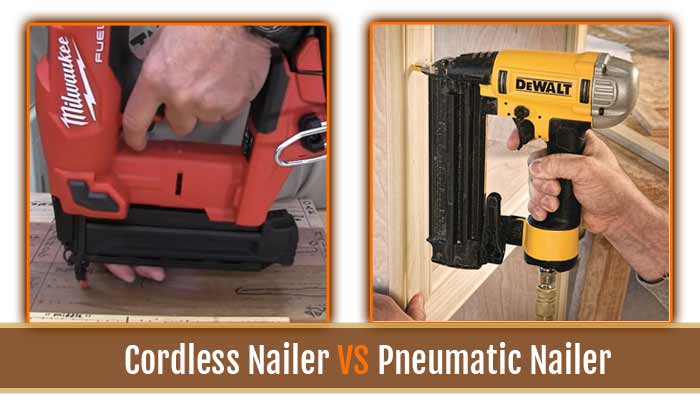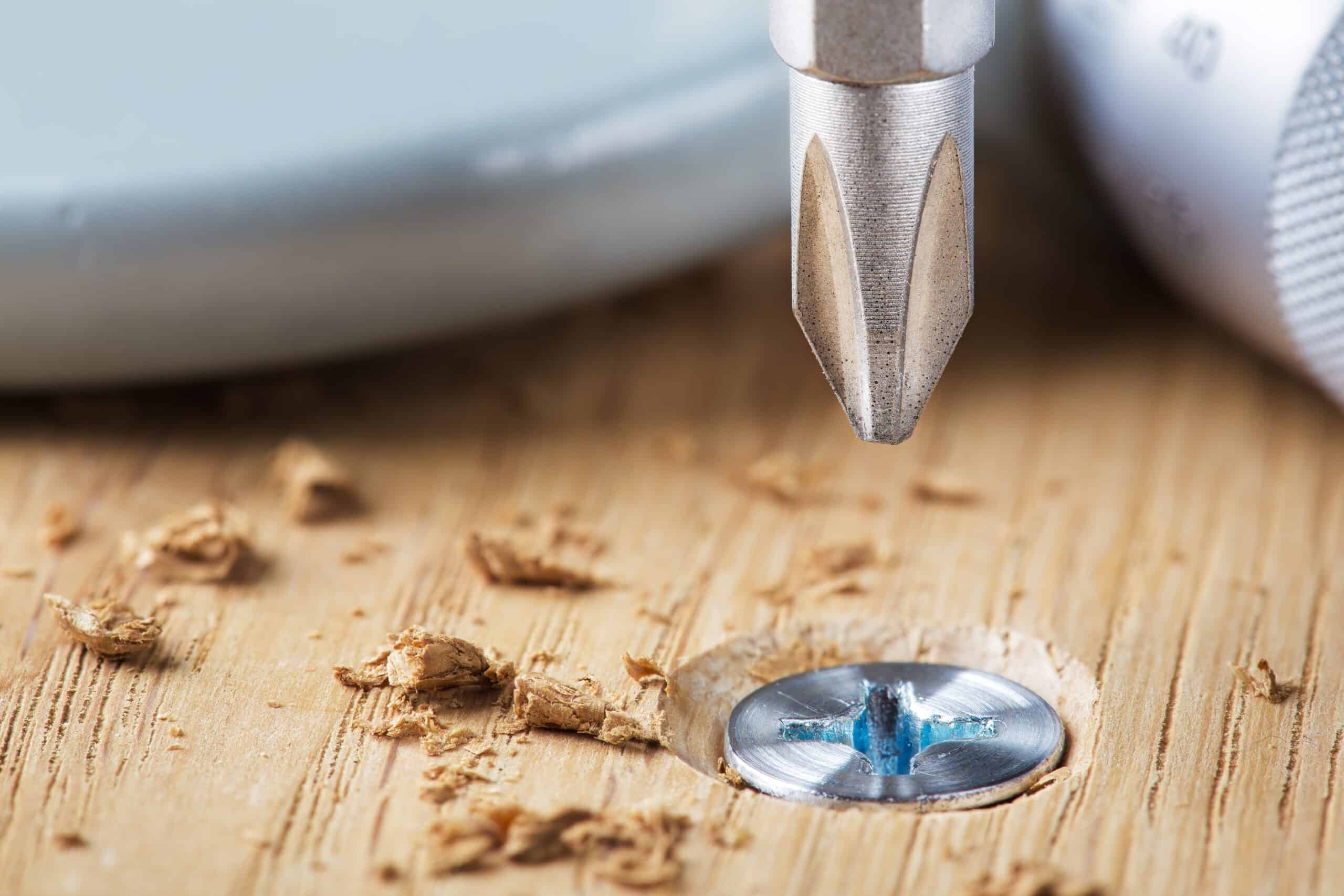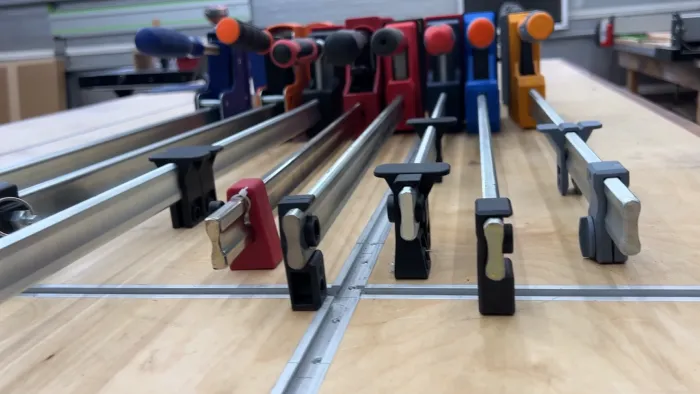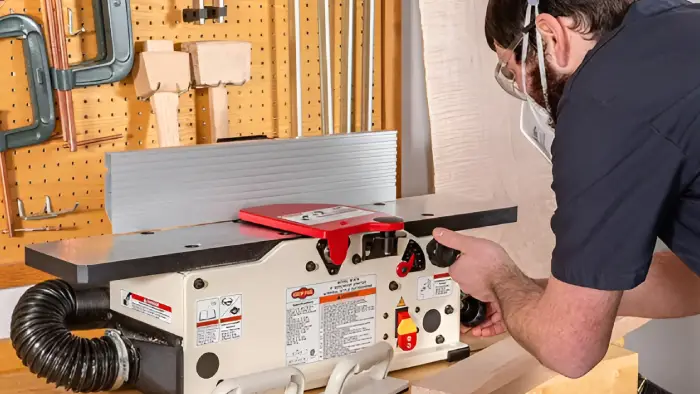WoodenuKnow.com is a participant in the Amazon Services LLC Associates Program, an affiliate advertising program designed to provide a means for sites to earn advertising fees by advertising and linking to Amazon.com and may earn from qualifying purchases.
Cordless and pneumatic nail guns are the two most commonly used nailguns. While cord-free types may offer you convenience of maneuverability, the pneumatic one will help you go through all your nailing needs with little effort.
As a result, you may be uncertain about which nailgun you should use.
Therefore, you must understand the difference between a cordless vs pneumatic nailer. Having this knowledge will allow you to identify the appropriate tool for the right job.
In this article, we will discuss the differences between pneumatic vs cordless nailers, how each of them works, how to use each of them, and answer some FAQs. Continue reading to find out what tools are best for your job.
Cordless Vs Pneumatic Nailer: What’s The Difference?
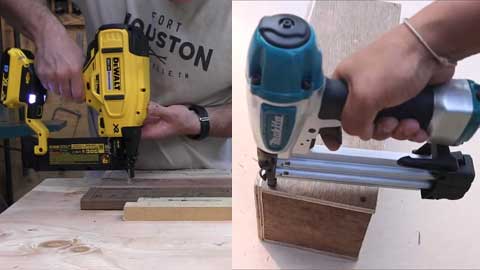
Cordless and pneumatic nail guns are both essential tools for home contractors and DIY enthusiasts. Nevertheless, they are not created equal.
They differ substantially from one another. Following are some of the major differences between pneumatic vs cordless nailers.
1. Source of Power
The power source is the major distinction between pneumatic vs cordless nailers. Cordless nail guns run on batteries, while air compressors power pneumatic ones. The majority of cordless nailers use 18 to 20 volt rechargeable lithium-ion batteries.
The great benefit of cordless tools is that they can be used anywhere and do not need to be attached to a power supply. Alternatively, a pneumatic finish nailer must be connected to an air compressor in order to operate.
2. Power
Another vital distinction between cord-free and pneumatic finishing nailers is power. A cordless nailer is often less potent than a pneumatic one due to the motor’s limited capacity.
Pneumatic models are powered by an external air supply, which allows them to generate more force. You can use a pneumatic finish nailer for larger projects requiring higher power. Most pneumatic nailers require air pressure between 70 to 90 PSI.
3. Performance

Performance can be a key determinant when choosing between cord-free and pneumatic nail guns.
In general, cordless models are designed for smaller jobs such as picture framing, while pneumatic ones are suitable for larger projects like roofing. Also, the range of a battery powered cordless nailer may be shorter than that of its air-filled counterpart.
Compared to cord-free battery powered nail guns, pneumatic nailers fire at a faster rate. Cordless nailers have a slower firing rate than air-filled nailers.
4. Portability
Portability is another factor to consider when choosing between cordless guns and air-filled nailers. The cordless brad nailer is portable and is easy to transport.
Alternatively, an air-filled model is somewhat less portable since it requires an external air supply.
5. User Friendliness
On the whole, cord-free nailers are easier to use compared to air-filled ones. Battery powered cordless nailers do not require an external air supply, which entails easy access.
Pneumatic models are less accessible due to the need for a decent compressor attachment. This makes it harder to store and transport them.
6. Weight and Size
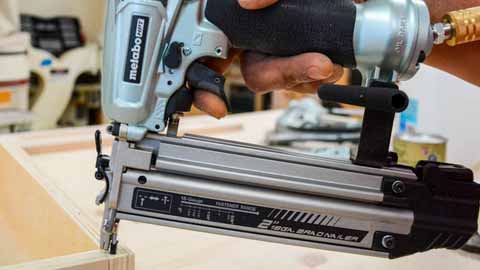
Another difference between cord-free and pneumatic nailers is their size and weight. A cordless nail gun is bulkier than their air-filled counterparts since they have an internal battery.
For example, pneumatic brad nailguns weigh approximately 2 pounds. As for cord-free brad nailguns, they weigh approximately 5 pounds.
Air-filled models are slimmer due to their compressed air requirement. The overall size of a cordless model depends on the number of batteries it carries.
7. Run Time
The run time is the length of time a nail gun can work without stopping for recharging. It is measured in battery life or rounds per charge.
The cordless version has limited run times, which means they must be recharged often. This limits their use since you cannot use them continuously for large projects.
On the other hand, air-filled framing nailer models offer a greater run time. They typically have larger air tanks, enabling them to work for longer periods without stopping or recharging.
8. Cost
In general, cord-free brad nailers are more expensive than pneumatic ones. Cordless framing nailer requires the purchase of rechargeable batteries and chargers in addition to the nail gun itself.
This increases their overall price tag. In contrast, an air-filled model only requires an external air supply. If you already have a compressor, your cost for a pneumatic nail gun will be much lower.
How Do Cordless Nail Guns Work?
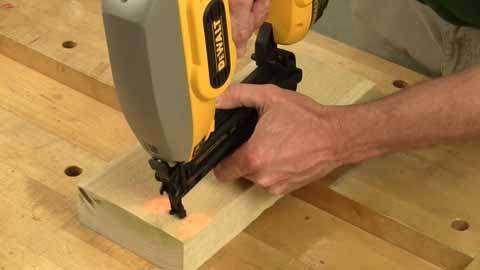
A cordless nail gun works by having an internal battery that powers a pneumatic piston.
When the user pulls the trigger, this triggers force and pushes the piston through several channels to ultimately shoot out a nail. When the trigger is released, a clutch will activate and stop all movement to prevent jams.
How Do Pneumatic Nailguns Work?
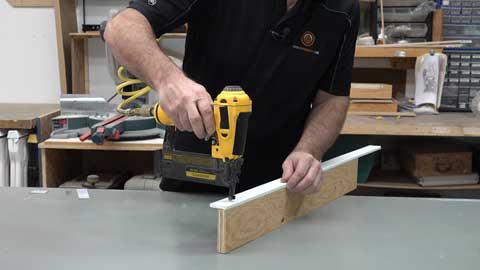
An air-filled nail gun works by using compressed air to drive a piston that then drives out nails.
There is an intake valve, channel, and exhaust valve in the gun’s mechanism that uses the air supplied by your compressor. The nail gun has a trigger attached to the mechanism that will activate the device when pulled.
How to Use the Cordless Nailer?
Cordless electric nail guns work differently than pneumatic ones. The cordless nailer typically has a battery that powers the mechanism. Here is the step-by-step guide to using cordless models:
Step 01: Prepare the Nail Gun
Firstly, you will need to prepare the nail gun for use. Check for a full charge on the battery. If it is already drained, ensure that you have fully charged your battery before using your cordless nailer.
Step 02: Load the Gun With Nails and Battery
Open the magazine and load in nails depending on the desired length of the nail. Some models require you to fill each channel individually.
Slide in your battery and make sure it is securely fastened into place before usage. If necessary, adjust or change your depth setting according to the desired depth of the nail.
Step 03: Select Your Driving Mode
Choose whether you want to set this nail gun in sequential or contact mode. Grip your device firmly with your dominant hand before using it.
Press the trigger until you feel it click into place, then pull back on it slightly to ensure that the mechanism is engaged.
Step 04: Fire
Aim your device at the surface you are nailing into. Press your free hand against the contact tip of your nailer to keep it in place while shooting.
Pull the trigger slowly until you feel that the mechanism is about to fire, then release it fully. Press the trigger again to shoot another nail. Continue this process until you have completed your nailing task.
Step 05: Unload the Nailer
After you are done with your nailing project, remove any nails left in the chamber. Replace them with a fresh set if necessary.
Remove the battery and place it back into a charger to recharge it or to store it for later use.
How to Use a Pneumatic Nail Gun?
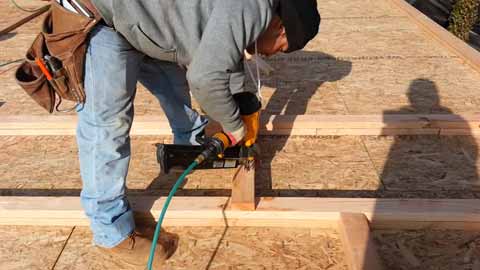
A pneumatic nail gun is very simple to use. Here are the steps:
Step 01: Prepare Your Compressor
First, you need to prepare your air compressor. Plug the air compressor into an electric power outlet.
Turn it on and allow for it to run until you get a reading on the air tank. Most compressors have gauges that will tell you when your air pressure levels are high enough. For convenience, you may choose a portable compressor.
Step 02: Prepare the Nailer
Load nails into your air-filled nail gun by pulling back on the magazine handle until it locks in place.
Press down on the contact tip to ensure it is close enough to fire but not touching the surface. Check that your depth setting is correct for the type of nail you are using.
Step 03: Select Your Firing Mode
Decide if you are going to use sequential or contact firing mode with this pin nailer. Choose whether you want to set this power tool in bump-fire or single fire mode. Attach the safety tip to prevent any accidents.
Step 04: Fire
Press down on the tip of your nailer firmly to make sure it is touching the surface you want to shoot.
Once it is pushed away from the head of your gun, squeeze the trigger and hold it until you hear the air-filled nail gun shot. Continue to press the tip firmly against the surface while shooting nails.
Step 05: Remove Any Jammed Nails
After you are done with your project, remove any jammed nails that may be left inside your gun.
Make sure all of your nails have been fired before putting your air-filled nail gun away.
Pneumatic vs Cordless Nailer: Which One Should You Pick?
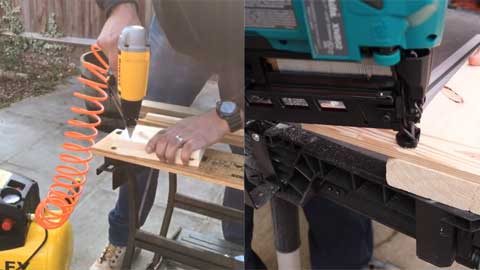
When you think about it, there isn’t really a winner between cord-free and air-filled nail guns. It all comes down to your preferences and needs.
If you are only planning on using the nailer for small-scale projects, then a cord-free battery powered nailer would be ideal. You should choose the pneumatic tool if you are considering something major.
We recommend using both cord-free battery powered nailers and pneumatic nail guns for professional workers. Using both of these devices together will give you the best results regarding efficiency and productivity.
Tip for Safe Use of Cord-free Nailers and Pneumatic Nailers
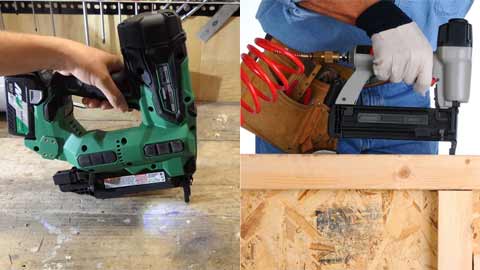
Safety should always be a priority when using these tools. Always wear protective gear before using a cord-free brad nailer or air-filled nail gun. Safety glasses, dust masks, and earmuffs are highly recommended when working with these tools for long periods.
Both cord-free and air-filled nail guns can be very dangerous if not handled properly. Nails that are shot out of these tools can cause injuries.
Be sure to turn off the triggers before transporting or storing them. Always keep these tools away from children, pets, and other people unfamiliar with their uses.
FAQs:
The following are some of the most common questions people ask about these tools:
Is It Better to Use Cord-free Nail Guns?
It depends on what you intend to use the nail gun for. Cordless electric nailers are great for home and personal use because they can be taken anywhere and used anywhere at any time without having to worry about a power outlet.
They are designed for small-scale projects. So, if you are working on small projects, cordless finish nailers can be a better option for you.
What is the Limitation of Using a Pneumatic Nail Gun?
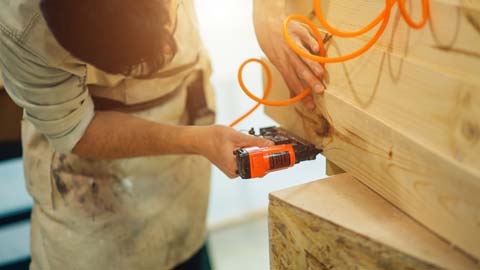
The limitation of using a pneumatic nail gun is that it needs to be attached to an air compressor. You must have access to an electrical outlet if you intend to use an air nailer.
It may not be a problem for most people, but some are looking for more portability from their tools. If you are setting out for a large project requiring more power, you should start with an air-filled nail gun.
How Long Does a Cordless Nailgun Last?
It all depends on the brand and model you are using. Cord-free nail guns usually last for approximately three years or 1,000 recharging cycles. Of course, this will vary depending on your usage. It may be wise to choose a reliable brand, such as DeWalt cordless nailers.
How Far Can a Pneumatic Nail Gun Be Fired?
Pneumatic air nailers can fire nails for distances up to 500m. The firing range can even be greater or smaller depending on your specific model. You should check the specifications of the product you are using before trying to fire any nails.
Conclusion
At the end of the day, cord-free and air-filled nail guns will both provide you with a better work output.
If you do not want to rely on existing electricity or power supplies, then we recommend using cordless framing nailers. They tend to lack the versatility and range of pneumatic guns, but they still function well in small-scale projects.
We recommend getting an air-filled one instead if you intend on undertaking a significant or large-scale project. They may not be as portable as models based on cordless technology, but they still function well in any environment.
We hope you have now gained a better understanding of the differences between pneumatic vs cordless nail guns.

